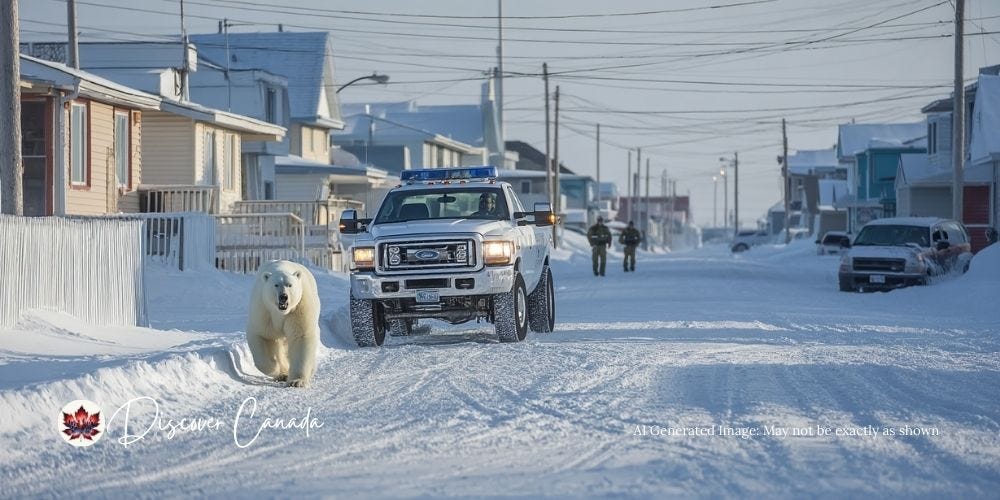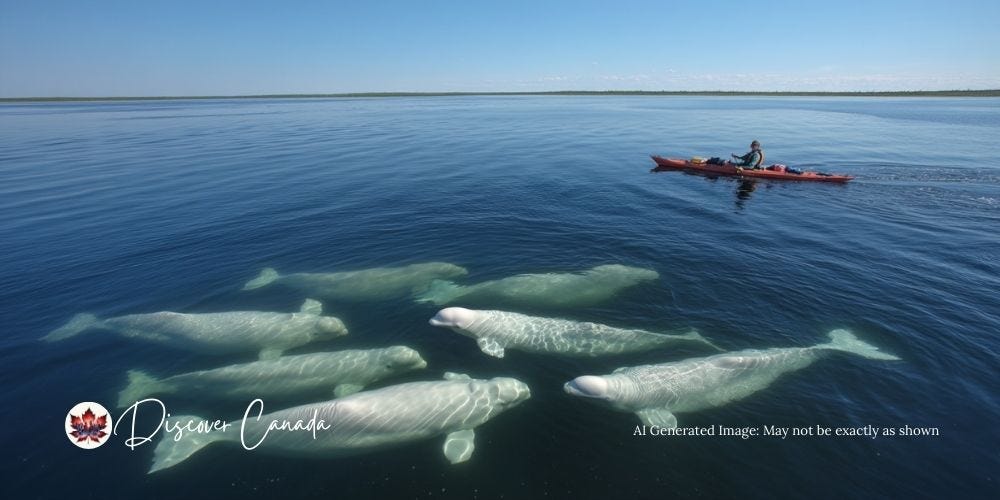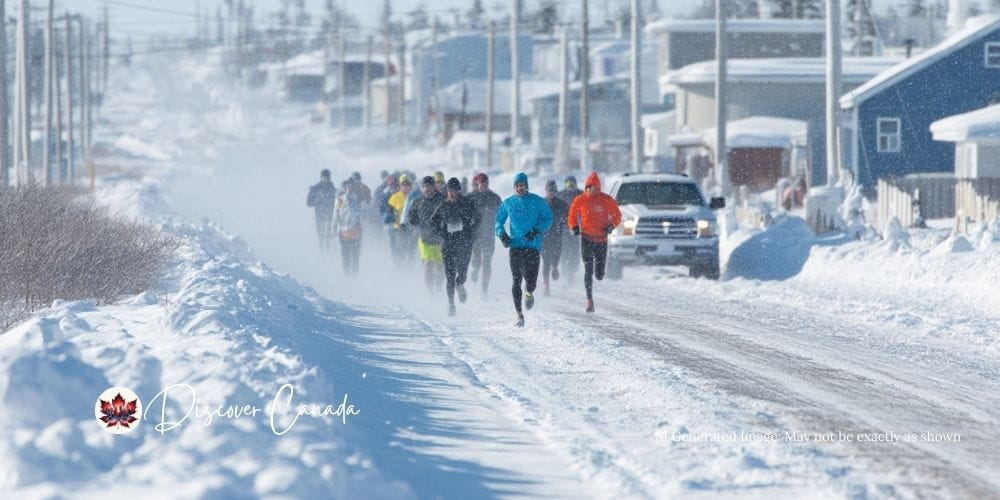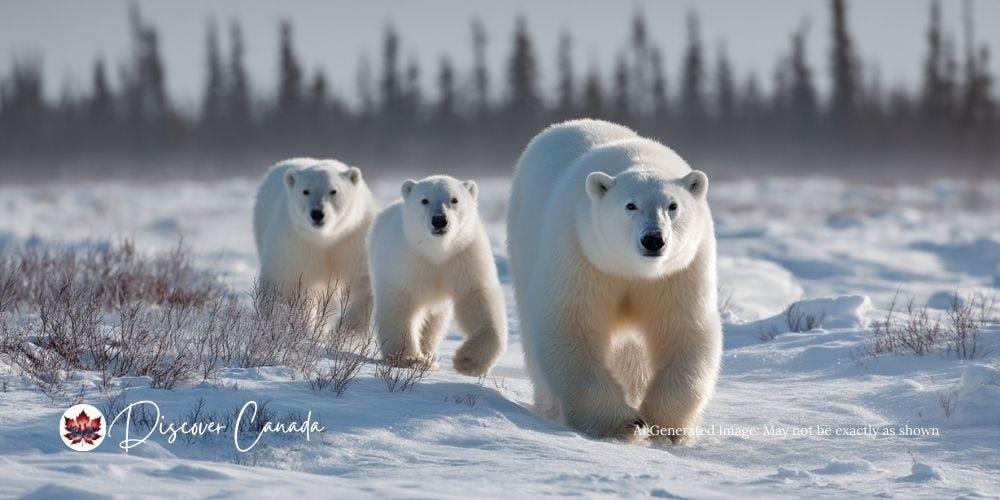Churchill: Polar Bears, Belugas, and the Northern Lights
Explore Canada’s Polar Bear Capital of the World — a frontier town where wildlife, culture, and conservation come together in unforgettable ways.
🎧 Listen While You Read
Hit play and let the audio bring Churchill to life as you discover why this remote town is known as the Polar Bear Capital of the World.
Polar Bear Capital of the World: Discovering Churchill, Manitoba
Introduction
Imagine standing on the wind-swept shores of Hudson Bay, your breath curling in the crisp northern air. Just beyond the tundra buggy’s frosted window, a massive polar bear pads silently across the snow — one of nearly a thousand that gather here each fall. Welcome to Churchill, Manitoba, the Polar Bear Capital of the World, where awe-inspiring wildlife encounters meet a community that has learned to live side-by-side with the Arctic’s most iconic predator.
But Churchill isn’t just about bears. It’s a place where the northern lights dance across winter skies, where thousands of beluga whales return every summer, and where Indigenous culture and conservation efforts shape the town’s future. In this story, we’ll explore what makes Churchill unique, how it balances tourism and tradition, and why its role in conservation matters more than ever.
📌 Key Takeaways
🐻❄️ Churchill is the Polar Bear Capital of the World — one of the best places on Earth to see wild polar bears up close.
🌌 It’s more than bears — think beluga whales in summer, the northern lights in winter, and endless Arctic adventure.
🛡️ Coexistence is key — from the Polar Bear Alert Program to the “bear jail,” locals lead in living safely alongside wildlife.
🌍 Sustainability matters — climate change, eco-tourism, and Indigenous leadership all shape Churchill’s future.
🐻 Why Churchill Is Called the Polar Bear Capital of the World
Every autumn, as the sea ice begins to form on Hudson Bay, nearly a thousand polar bears gather near the small town of Churchill, Manitoba. This unique migration has earned the community its famous nickname: the Polar Bear Capital of the World. Few places on Earth offer such reliable and safe opportunities to witness these majestic animals in the wild.
What makes Churchill special is accessibility. Unlike remote Arctic regions that require expensive expeditions, this northern town can be reached by train or plane from Winnipeg. Once there, visitors can board tundra buggies — specially designed vehicles that allow you to approach the bears in safety and comfort.
But Churchill is more than a tourism slogan. The nickname reflects a deep connection between people and wildlife. Residents share their streets, shorelines, and even backyards with the world’s largest land predator, adapting their lives around the rhythms of the bears. It’s a coexistence built on respect, vigilance, and awe.
🤝 Living With Giants: Churchill’s Culture of Coexistence
In Churchill, polar bears aren’t just a seasonal spectacle — they’re neighbors. For decades, the town has developed a remarkable system of coexistence that allows residents and wildlife to share the same frozen landscape with minimal conflict.
At the heart of this effort is the Polar Bear Alert Program, a dedicated team that patrols the community during peak bear season. Instead of resorting to lethal measures, officers use humane tactics like rubber bullets, cracker shells, and spotlights to steer wandering bears away from town.
When a bear refuses to leave, it may spend time in the famous polar bear jail — a holding facility where animals are kept safely until they can be released back into the wild once the sea ice returns. This approach has saved countless bears and kept the community safe, with no fatal attacks in over a decade.
Indigenous elders add another layer of wisdom to Churchill’s coexistence model. Their traditional knowledge emphasizes respect and restraint, seeing polar bears not as intruders but as beings with their own rightful place on the land. Together, science and tradition shape a unique safety culture that few other communities in the world have achieved.
🏚️ What Is Churchill’s Polar Bear Jail?
The so-called polar bear jail is one of Churchill’s most unusual — and effective — innovations. It’s not a punishment facility but a holding centre designed to protect both people and bears. When a polar bear lingers too close to town or shows signs of becoming a repeat visitor, it’s tranquilized and kept here in secure, climate-controlled cells.
Bears stay for days or even weeks, fed only water to discourage dependence on human food. Once the sea ice on Hudson Bay forms, they are safely released back into the wild, where they can resume their natural hunting patterns.
This unique system reflects Churchill’s philosophy: protect the community, but never at the expense of the bears. It’s an approach that’s been studied around the world as a model for human–wildlife coexistence.
🌍 Challenges and Sustainable Innovation
Churchill’s future as the Polar Bear Capital of the World is tied to forces far beyond its control. Climate change is shrinking the sea ice on Hudson Bay, reducing the time polar bears can hunt seals. Scientists warn that without action, populations could collapse by the end of the century. For a community built on coexistence and wildlife tourism, the stakes couldn’t be higher.
Yet Churchill is responding with resilience and innovation. Tour operators are introducing electric tundra buggies, reducing carbon emissions while offering quieter, more eco-friendly wildlife encounters. In town, new waste management systems like the BIOvator composter keep organic food waste from attracting hungry bears, helping both safety and sustainability.
Tourism itself is diversifying. While polar bears remain the star, many visitors now arrive for the northern lights in winter and the return of thousands of beluga whales each summer. This year-round approach eases pressure on polar bear season and supports a more sustainable economy.
Indigenous leadership plays a growing role too, blending traditional knowledge with modern science. Elders stress that protecting polar bears also means protecting the land and water they depend on — a message increasingly resonant in the global fight against climate change.
🏞️ Hidden Gems and Unusual Angles in Churchill
Beyond its title as the Polar Bear Capital of the World, Churchill holds stories that few visitors ever discover.
🌲 Wapusk National Park & Cape Churchill
To the southeast lies Wapusk National Park, home to one of the largest polar bear denning areas on Earth. At Cape Churchill, photographers capture some of the most iconic polar bear images ever published. It’s a rugged, raw wilderness where the Arctic feels untouched — a reminder that Churchill is a gateway, not just a destination.
🏃♂️ The Polar Bear Marathon
Every November, a small group of runners brave subzero temperatures and the possibility of bear sightings in the Polar Bear Marathon. Guided by armed escorts and warmed by sheer determination, participants take on one of the world’s most extreme races. It’s quirky, fearless, and pure Churchill.
🧑🎨 Local Arts and Indigenous Heritage
Churchill is also a cultural hub. The Itsanitaq Museum showcases Inuit carvings, tools, and artifacts that tell stories of survival and artistry in the North. Local shops carry soapstone sculptures and prints made by Indigenous artists, while the Polar Bears International House serves as both a research station and visitor center, offering a deeper understanding of the bears and the people who live alongside them.
🗣️ Voices of the Land
Indigenous elders remind us that polar bears are more than symbols of tourism. In Cree and Inuit traditions, they are respected beings with their own place in the circle of life. Listening to these voices adds depth to Churchill’s story — it’s not just about watching wildlife but about recognizing the land as shared territory, where humans are guests as much as the bears.
💡 Pro Tip: Timing Your Visit to Churchill
If you’re planning a trip to the Polar Bear Capital of the World, timing is everything.
October–November is peak polar bear season, when the bears gather along Hudson Bay waiting for the ice to form.
June–August brings the return of over 60,000 beluga whales, making Churchill one of the best whale-watching destinations on the planet.
December–March offers prime viewing of the northern lights, with the aurora visible up to 300 nights a year.
For up-to-date travel information and wildlife viewing seasons, check out Travel Manitoba’s official Churchill guide.
🌐 Why Churchill’s Story Matters
Churchill is more than the Polar Bear Capital of the World — it’s a lesson in coexistence, resilience, and responsibility. Here, a remote town and a powerful predator share the same frozen frontier. The balance is fragile, but it shows what’s possible when humans choose respect over conflict.
Climate change threatens to tip that balance. As sea ice vanishes, polar bears lose critical hunting grounds, and the community risks losing the very foundation of its identity. Yet Churchill’s innovations — from electric tundra buggies to Indigenous-led stewardship — show how tourism, conservation, and tradition can move hand in hand.
Visiting Churchill isn’t just about seeing polar bears. It’s about experiencing a model of how people and wildlife can share the land, and supporting a community at the frontlines of conservation. When you go, travel thoughtfully: book with local guides, support Indigenous businesses, and remember that every encounter is a privilege, not a guarantee.
If you can’t make it north, consider supporting organizations like Polar Bears International, which works tirelessly to protect both the species and the ecosystems they call home.
✨ Final Thoughts
Churchill, Manitoba, isn’t just a travel destination — it’s a reminder of how closely our lives are tied to the natural world. From polar bears to belugas, from the northern lights to Indigenous traditions, the town embodies both wonder and responsibility. Visiting here means stepping into a story where people and wildlife live side by side on the edge of the Arctic.
If you enjoyed this journey into the Polar Bear Capital of the World, make sure you’re subscribed to Discover Canada in Style so you don’t miss future stories that celebrate Canada’s wild beauty, hidden gems, and unforgettable adventures.
❓ Frequently Asked Questions
Curious about visiting the Polar Bear Capital of the World? Here are some common questions travelers ask before heading north to Churchill, Manitoba.
🐻 When is the best time to see polar bears in Churchill?
The best time to visit Churchill for polar bear viewing is October and November, when the bears gather along Hudson Bay waiting for the ice to form. Guided tundra buggy tours during these months provide safe, close encounters with wild polar bears.
🌌 Can you see the northern lights in Churchill?
Yes! Churchill is one of the world’s premier northern lights destinations. The aurora borealis is visible up to 300 nights a year, with peak viewing from December to March. Many tours combine polar bear season or winter adventures with aurora photography opportunities.
🐋 What other wildlife can I see in Churchill besides polar bears?
Summer brings over 60,000 beluga whales into the Churchill River estuary, making it one of the best places on Earth for whale-watching. Visitors may also spot snowy owls, Arctic foxes, and even caribou, especially in nearby Wapusk National Park.
🚆 How do you get to Churchill, Manitoba?
Churchill is remote and has no road access. Visitors can fly in from Winnipeg or take the Hudson Bay Railway, a scenic multi-day train journey across the prairies and boreal forest into Canada’s Arctic frontier.
🏚️ What is Churchill’s Polar Bear Jail?
The polar bear jail is a holding facility where problem bears are kept temporarily when they wander into town. They are released back into the wild once the Hudson Bay ice forms. This unique system protects both residents and wildlife.






